Niigata
Personal narrative of life at Niigata
Click here for map showing location of Niigata 5.
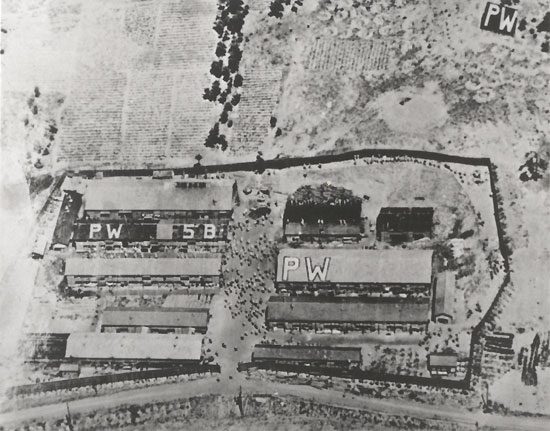
More photos at end of report.
LOCATION
Located about 160 miles Northwest of Tokyo, Camp No. 5B was one of the more remote camps in the Tokyo Group of P.0.W. camps. It was situated on the northern outskirts of Niigata (37° 58' N., 139° 02 E.), a seaport on the Sea of Japan along the cold and during the winter, very snowy west coast of Honshu island. The city had a 1940 population of almost 151,000 people, but the port and local industries, like many others in Japan at the time, were still far behind most of the western industrialized nations.
PRISONER PERSONNEL
Camp No. 5B at Niigata was opened on September 3, 1943 with the arrival of 300 P.0.W.s from Hong Kong. This group was composed mostly of Canadian soldiers with some men of the Hong Kong Volunteer Defence Force, as well as Dutch sailors , the surviving crewmen of a submarine sunk by the Japanese off Java. This initial contingent had no officers or doctor. They, with about 200 additional P.0.W.s, had sailed from Hong Kong in the latter part of August on the small two hold Japanese collier, the "Manryu Maru," stopping briefly at Taihoku (Taipei) the capital of Formosa (Taiwan) en route to Japan. Upon their safe arrival at Osaka, Japan the 500 P.O.W.s were split up, with one group sent by train to Niigata and the remainder to other camps in Japan.
On September 20, 1943 the small Japanese freighter "Taga Maru left the Philippines with a draft of about 800 American P.0.W.s and after a stop at Takao, Formosa safely docked at Moji, Japan on October 5th. Almost 350 men of the group, enlisted men of all services, were sent to Camp No. 5B at Niigata arriving on October 7, 1943.
On October 20th, five American officers and three army medical corpsmen arrived, led by Major Francis Fellows of the Field Artillery, captured on Corregidor, an authority on the Civil War, who then became the senior officer in charge of the P.0.W.s at Camp No. 5B.
On October 30, 1943 Major William Bill. Stewart, R.A.M.C. was transferred to Camp No. 5B from Camp Kawasaki 1B in the Tokyo area. Stewart, a doctor from Northern Ireland, had served with the British army defending Singapore but he managed to escape to Java in a sailboat. He eventually was captured with 160 officers and the crew of a British ship when sunk by a German raider as they attempted to sail to Australia. In October 1944 the Japanese authorities reported that Branch Camp No. 5B held 215 Americans and 354 British, Canadian, Dutch and other Allied P.0.W.s.
By the end of May 1945 an additional 200 American, British and Australian enlisted men and 26 officers including two doctors who had been bombed out of P.0.W. camps in the Tokyo-Yokohama area arrived at the now overcrowded camp No 5B. During the first week of July 1945 about 150 American civilian construction workers captured at the fall of Wake Island were transferred from the Kiangwan Camp in Shanghai via Fengtai, China to Niigata, which for the last few months of the war was comprised of a conglomerate of P.0.W.s, all from Allied forces in the Far East.
JAPANESE PERSONNEL
From its opening on September 3, 1943 until its closing almost two years later on August 21, 1945, Camp 5B at Niigata had three camp Commandants.
The first was the psychotic Lt. Masato Yoshida, a small, squat, smartly dressed, but ugly man whose appearance was not enhanced by thick horned-rimmed glasses and two or three steel-capped front teeth. He could, when he wished, communicate with the P.O.W.s in English. It was later proven that Lt. Yoshida had sold food, medicines and other Red Cross supplies Intended for the prisoners, in the Niigata black market. After the war ended he was apprehended, tried and hung for his complicity In a series of war crimes. Yoshida remained Commandant at Niigata about 6 1/2 brutal months until mid March of 1944 when he was succeeded by 2nd Lt. Nemoto who took more interest in the camp and attempted to curb the often irresponsible and sadistic behavior of many of the guards.
During Nemotos tenure the P.0.W.s were allowed to purchase at a music shop in Niigata, with yen paid to the few officers, a trumpet, guitar and banjo and form a combo led by American Marine Sgt. George Francis which presented small informal outdoor concerts boosting the camp's otherwise very low morale. In September of 1944 the last Commandant took charge.
He was Lt. Tetsutaro Kato, tall and big-boned for a Japanese, he too wore heavy horn-rimmed glasses and soon acquired the nickname of "Four Eyes." A strict disciplinarian with both P.0.W.s and guards, he improved conditions in the camp. However, at times he would fly in to uncontrollable, wild rages, followed by apparent periods of remorse. This madman, affectionately raised six egg laying hens in an enclosure behind his quarters. In July 1945 Kato personally executed by bayoneting an American Mormon P.O.W. named Frank Spears who was recaptured after wandering off in a mentally unbalanced state on another of his unsuccessful escape attempts. Lt Kato was also a defendant at the post war War Crimes Trials (see photo below).
Serving as an Adjutant to each of the camp Commandants was the hated Sgt. Ito who was later hanged. In charge of the medical facilities was the incompetent Medical Corporal Takeo Takahashi (see photo below). The camp interpreter was a Japanese-American named Shiga who was a graduate of the University of Washington. His parents had sent him to Japan just prior to the war for additional schooling at a Japanese University. Met at the boat upon arrival at Yokohama he was immediately drafted" into the Japanese army. He was said to have been good to the prisoners, at times giving them news of the war and always insisting that the Japanese would lose the war. After a short period of time, Camp No. 5B at Niigata, with the above cast of characters in charge, soon acquired the reputation of being a "horror" camp.
HOUSING AND CAMP FACILITIES
When the camp was opened on September 3, 1943 conditions were abysmal. Housing for the initial 300 P.0.W.s consisted of a single two-story wooden building with a small yard. One outdoor pump provided the water supply with no other washing facilities. The outdoor toilet or "benjo" at one end of the barracks was totally inadequate for the number of men, most of whom suffered from chronic dysentery. In addition, a small hut in the yard served as a cook shack. The barracks consisted of about 10 large rooms separated from each other by paper thin walls connected by a narrow hall running down one side of the structure. About 30 or more P.0.W.s were crammed into each room with a 3 1/2' x 6 1/2' space for each mans cotton blanket and hard little pillow. One room was designated as a "hospital ward". Originally intended only as a temporary camp until construction of the permanent camp was completed, it remained in use almost 4 months until December 24, 1943. On that date the approximately 550 P.O.W.s were transferred to a new camp only partially completed, which was in even worse condition than the abandoned camp. The wood clapboard buildings still lacked windows and the openings had been roughly boarded up, leaving large cracks for rain, snow and the cold winter weather to enter the unheated barracks. No kitchen had been built and food, what little there was, was cooked about two miles away, and after local pilferage, the short rations were brought into the camp cold. No water supply had been installed necessitating bringing water in in large wooden barrels. Then at 2:00 A M on New Years Day 1944, only a week after arrival at this horrendous, unfinished facility, one of the barracks collapsed with 50 sleeping P.O.W.s inside, killing eight and seriously injuring 12. Despite all the turmoil in camp and the cold, snowy conditions outside, the daily work parties continued as usual. By mid-January of 1944 the Japanese acknowledged the obvious failure of this second camp and relocated the men to their third place of residence in four months. With this move the original camp was split into two sections. Shintetsu (the iron foundry group) were now billeted in a building near the foundry and had no contact with the P.0.W.s in the other two work parties until the war ended. The remaining P.0.W.s in the Rinko Coal and the Marutsu Dock details were moved to a greatly improved although still overcrowded building closer to their work site on the Niigata docks. On April 1, 1944 this group was returned to the now completed camp located on a rise of ground just outside of Niigata and here they remained for their last 18 months of internment at Niigata Camp No 5B. This permanent camp was surrounded by a high wooden fence with a double gate in the center of one side with an unused watch/bell tower in one of the corners opposite the gate. The camp contained 13 or 14 various sized wooden structures including the following; several larger barracks for the P.O.W.s, the camp Commandant and guards quarters and a guardhouse, a shack utilized as a first-aid dispensary, a kitchen, a large and very welcome bathhouse, latrines, a few storage and other miscellaneous sheds and a vital necessity, running water.
WORK
The Camp 5B internees, who were deemed healthy by the Japanese Medical Corpsman
Takahashi, were engaged in three work projects outside of the camp. Reveille wars at 5 a.m. in with roll call at 6 a.m. The work parties left the camp about 6 30 a.m. and began the march home at 5 p.m.
1) The Rinko Coal Yard detail located at the docks almost two miles from the original camp site was reputed to be the toughest assignment. Coal was shipped to Japan from mines in occupied Manchuria and the P.0.W.s unloaded it into small cars each holding about a half ton. The cars were pushed along rails mounted on an archaic, rickety trestle about 30 feet off of the ground and dumped at different stockpiles around the dock or at times directly into a railway coal carrier on the tracks below. Other coal cars were loaded by P.0.W.s using "yo-ho" poles, i.e., a wooden pol;e with a wicker basket hinging on each end with the load balanced on the bearers shoulders, under the adverse conditions a difficult endeavor even for an experienced coolie. The underfed P.0.W.s, many lacking solid shoes and warm clothing worked outside in this grimy environment in all kinds of weather on this most arduous detail with the only material reward being the coal that they brought back to burn in the barracks stoves. This inefficient operation was managed by a Japanese civilian named Kojima, an older man with a long black beard. "Whiskers" as he was known to the P.0.W.s, spoke quite tolerable English, but he proved to be a hard taskmaster and he was indirectly responsible for many deaths although he managed to evade punishment later at the War Crlmes trials. His foremen referred to as Honchos supervised the P.O.W.s and the Japanese men and women in the work detail The Honchos were all discharged army veterans of the China campaign. A few were decent but the majority varied from plain mean to outright psychotic, with Sato being the worst of the group. In the latter period of internment with the war going badly for Japan most of the tougher Honchos and guards at Niigata were replaced.
)) The Shintetsu Iron Foundry detail did general labor within this primitive and hazardous facility. The only advantage to working at the foundry was that it was an inside job and warm during the winter months. In mid-January 1944 the men working in his group were moved to a new building near the foundry and they remained separated from the other P.0.W.s at Camp No. 5B until the war ended.
3) The Marutsu Dock Yard detail did the work of stevedores on the Niigata piers. This job was considered the choicest of the three since it provided the P.O.W.s with the opportunity to pilfer food and other valuable commodities shipped home from the occupied lands of the Co-Prosperity Sphere.
MEDICAL FACILITIES
When the camp opened only Cpl. Takeo Takahashi, a Japanese Medical Corpsman was in charge of P.0.W. health care. A vain, pompous, compassionless little man, Takahashi had been a dental assistant before the war and he made no attempt to hide his contempt for the prisoners. In the two months prior to the arrival, on October 30, 1943, of Major Bill Stewart, R.A.M.C. seven of the original P.O.W.s had already died due to a lack of medicines, inadequate food, overwork in unsafe conditions and the total incompetence of Cpl. Takahashi. Major Stewart set up a 30-mat sick bay in a room in the barracks, but despite his best efforts during the first winter many of the P.OW.s quickly caught pneumonia due to a lack of warm clothing and shoes and their lowered resistance brought on by food of very low nutritional value, as well as the terrible housing conditions. In an attempt to exempt as many of the sickest men from work, Dr Stewart set up an evening sick call in the corridor outside of his "hospital". Although only about 10% of the P.0.W.s were well enough to engage in any physical labor, the Japanese attitude was that the P.0.W.s were there to work and they would work or die. Of the original 300 Canadian P.0.W.s, 102 would perish of a multitude of diseases and accidents during their two year stay at Camp 5B and many more returned home after liberation infirm for the rest of their lives. The P.O.W. death rate at Niigata was extremely high, reputed in fact to be the highest of any camp in Japan (a claim also made by survivors of several other camps), although no statistical evidence is available to substantiate the sad fact.
FOOD
Within a short period of time, food, or the continual shortage of it, became an all consuming fact of life. For men engaged In hard physical labor the starvation level diet led to immediate malnutrition and quick weight loss and the subsequent lowering of resistance causing a variety of diseases, due to a lack of basic nutrients, especially protein.
The basic menu, similar to that of other mainland Japanese camps consisted of rice, barley, sorghum, a purple cereal called Korian, an occasional potato and the ever present daikon (a giant radish). On rare occasions a small piece of poor quality fish, seaweed or grasshoppers soaked in soy sauce would be served as luxuries. Breakfast and supper were eaten in camp, but lunch was brought from the camp to the work sites in a hand pulled 2-wheel cart and was cold by arrival.
The kitchen, as well as other choice in-camp jobs, was run by the contingent of Dutch sailors who during the two year stay at Camp 5B managed to remain together as a well knit group.
Men on the sick list and unable to work, had their already insufficient and almost nutritionless food ration cut in half causing less likelihood for their change of recovery, a fact that the Japanese authorities chose to ignore.
In January 1944 the P.0.W.s received their first Red Cross parcels which had been turned over to the Japanese in late October 1943 by the American chartered Swedish exchange ship Gripsholm. This distribution of food and comfort items proved to be a great morale booster, if only for a brief period. By early 1945 as the war situation worsened for the Japanese, incoming shipments of food from the occupied areas became increasingly scarce, causing even greater hardships for both the P.0.W.s and the now starving civilian population.
When the camp was liberated, undistributed food, clothing, and medical supplies that would have helped to save lives were found in storage sheds, an occurrence common in many of the P.0.W camps in Japan.
CORRESPONDENCE
Mail originally addressed to Canadians in Hong Kong, was re-directed to Camp 5B and distributed initially in October 1943 and again in February 1944 and possibly at later dates. Letter sheets in printed envelopes left Niigata sometime in mid-1944 with Niigata listed as the camp in the return address This outgoing as well as incoming mail from Canada and the States bear the personal "chops" of Uyemori and 2nd Lt. Nemoto and 1st Lt. Kato, the last two camp Commandants, as well as Onishi, a censor stationed in Tokyo. All of the incoming mail bears the manuscript "5B" notation and sometimes, but not always, the P.0.W.'s assigned number appears. Little mail has surfaced in the U S from the several hundred American P.0.W.s interned at Camp 5B for almost two years.
Sacks of mail, duly censored but undistributed to the P.O.W.s, were "liberated" by occupying American forces and quite a few pieces have appeared over the years in the market via stamp dealers directly or through postal and military history auctions.
LIBERATION
The Camp No. 5B internees were declared free on or about August 21, 1945, but they left by train for Tokyo on September 5, 1945. Some were flown to Manila and others were transported on naval vessels to San Francisco with stops at Guam and Honolulu, Hawaii. Howard Chittenden flew home from Tokyo with stops at Guam, Kwajalein, Johnston, and Honolulu.
End of Report
British and American POWs from Yokohama 18-D were notified on 4 Jun45 they were to leave for Niigata. They marched to the train station, arriving at 7:30 pm. Ninety seven men made the ten hour trip. They marched what they thought was about 2 miles from the town to the camp. Their first meal was a bowl of barley, soup, pickled dikon, and fish. That night they had bread, thick bean soup, dholl mash, and fish. Roll call at seven, lights out at eight. They would be assigned to work with coal or as stevedores.
On 2 Jun 45 about 150 civilians from Kiangwan in Shanghai arrived.
10 Aug 45
the area was bombed about 11 am causing several casualties among Japanese workers
12 Aug 45
at mid-night POWs were told to prepare to leave camp. An hour later they went back to bed. That day they heard Russia had entered the war.
15 Aug
Japanese allow some 30 men to leave camp to go swimming
16 Aug
rumors about the war being over. Maj Fellows said he had no official word. POWs did not work after that.
20 Aug 45
Camp commander returned from Tokyo. After evening roll Major Fellows told POWs an armistice had been reached
22 Aug 45
a baseball field was set up outside camp, 90 men went swimming
The book DEATH MARCH The Survivors of Bataan by Donald Knox contains many references to Niigata in the last few chapters. The information below is from those references:
Food at Niigata was usually boiled soybeans in a soup and steamed rice. Sometimes some type of stewed fish was included.
Bathing was allowed once a week.
Snow the winter of 1944-45 was heavy.
POWs unloading coal worked as follows-Some POWs would shovel coal in to large steel nets in the hold of a ship. Another group would shovel the coal on to a conveyor belt. The belt carried the coal to small cars which other POWs then pushed to a location where the coal was dumped into rail cars or on to the ground. Teams of 4 POWs would then load the dumped coal into 2 gondola railroad cars a day. If they did not meet this quota they were beaten.
Some of the stress of the daily life of a POW can be explained here. Some of these jobs were easier than others. Stronger, healthier POWs would often force their way on to these easier jobs. If you were in a small crew you tried to stand away from other POWs you knew to be sick or weak. Every day a POW was forced to decide how much to help other POWs. Help them too much and you weakened yourself. The food quality and quantity was such that caloric intake was less than the calories used by the work the POWs were forced to perform.
Photo below of the guards and POWs at Niigata in 1943. There were no North China Marines at Niigata until May of 1945.
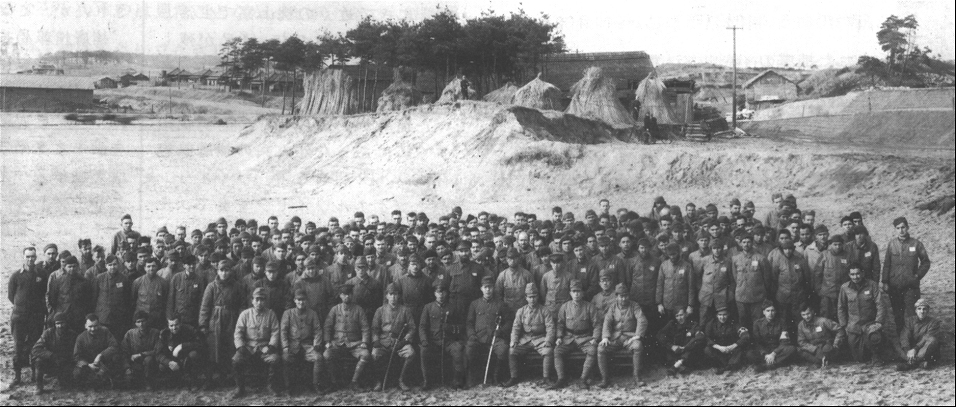
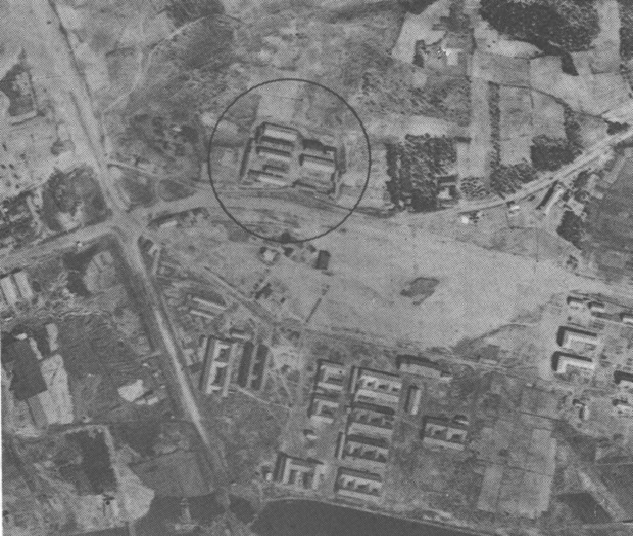
Photo of the camp in 1947above. This photo, the ones below, and the one of prisoners and guards in 1943 are courtesy of Greg Hadley, Coordinator, Communicative English Program, Niigata University of International and Informative Studies. Greg has been in contact with Howard Chittenden in regard to a book he is writing on Niigata 5-B. Photos below, taken after the war, show how the POWs worked on the docks loading coal. (They are all NARA photos)
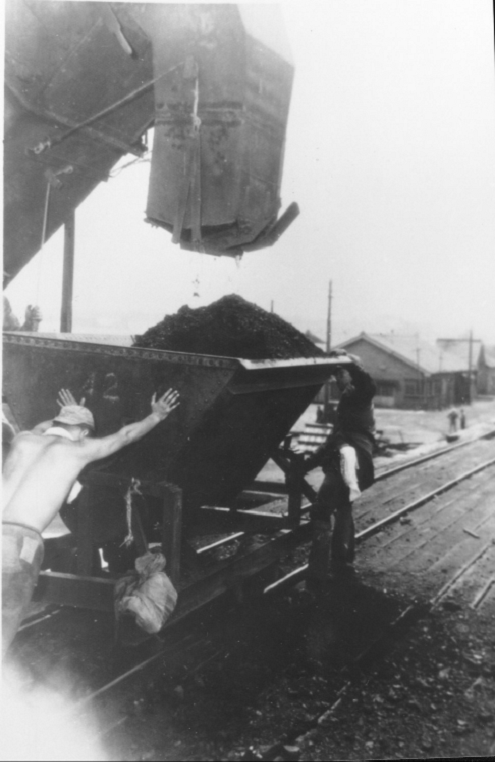
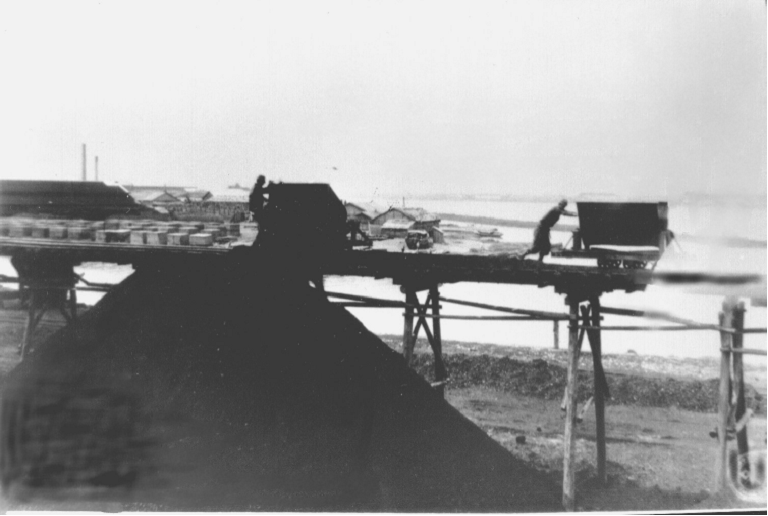
Scroll back to the top